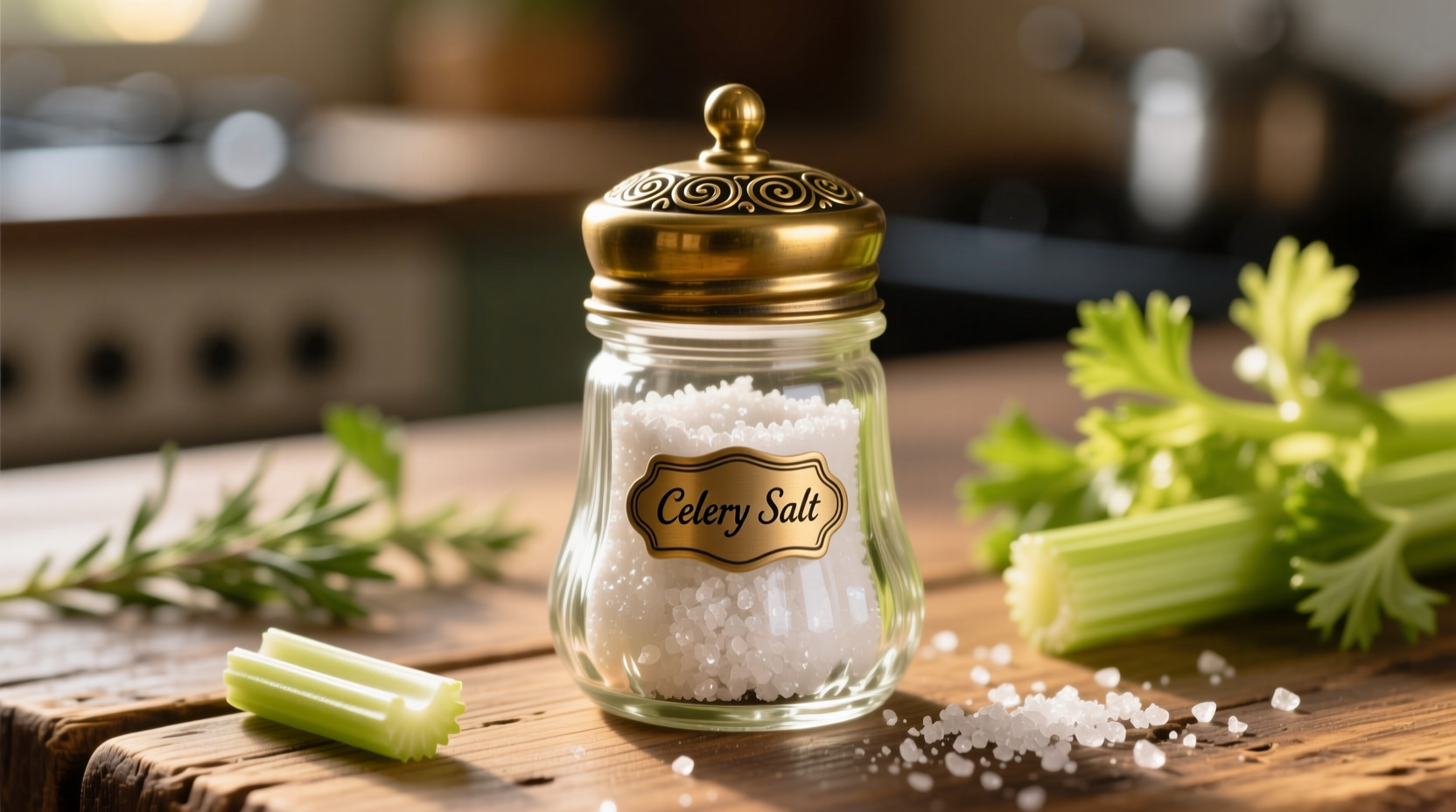When you reach for that shaker of celery salt, you're tapping into a culinary secret weapon that professional chefs have relied on for generations. This simple blend transforms ordinary dishes with its unique herbal-savory profile while providing up to 30% less sodium than regular table salt. Whether you're crafting the perfect Bloody Mary, seasoning roasted vegetables, or elevating your potato salad, understanding celery salt's properties will immediately improve your cooking results.
What Exactly Is Celery Salt?
Celery salt consists of finely ground celery seeds combined with salt, usually in a 3:1 ratio of salt to seeds. The celery seeds come from the Apium graveolens plant, the same species that produces the celery stalks we eat. When processed correctly, this blend delivers a concentrated herbal flavor with subtle earthy notes and a clean saltiness that enhances rather than overwhelms.
| Seasoning | Composition | Sodium Content | Flavor Profile |
|---|---|---|---|
| Celery Salt | 3 parts salt + 1 part ground celery seeds | ~30% less sodium than table salt | Herbal, earthy, savory with subtle bitterness |
| Celery Seed | Pure ground seeds | Negligible | Intensely herbal, slightly bitter, concentrated celery flavor |
| Table Salt | Pure sodium chloride | 100% | Clean saltiness without additional flavor notes |
The Evolution of Celery Salt in Culinary History
Celery's journey from medicinal herb to kitchen staple spans centuries. Historical records show celery was cultivated in the Mediterranean as early as the 9th century BCE, primarily for therapeutic uses. By the 17th century, European gardeners began developing the stalk variety we recognize today, while the seeds remained popular in spice blends.
The specific combination of celery seeds and salt emerged in the late 19th century as food preservation techniques advanced. According to the USDA's historical food documentation, celery salt gained widespread popularity during Prohibition when bartenders used it to enhance the flavor of early Bloody Mary cocktails as a "sobering" seasoning.
How to Make Superior Celery Salt at Home
Commercial celery salt often contains anti-caking agents that diminish flavor quality. Creating your own ensures maximum freshness and control over the salt-to-seed ratio:
- Toast 2 tablespoons of celery seeds in a dry skillet over medium-low heat for 2-3 minutes until fragrant
- Cool completely (10 minutes)
- Grind with 6 tablespoons of flaky sea salt using a spice grinder
- Sift through a fine mesh strainer to remove larger seed particles
- Store in an airtight container away from light
This homemade version lasts 4-6 months while maintaining optimal flavor, compared to the 2-3 months of commercial blends. The toasting process activates essential oils that create a more complex flavor profile than pre-ground versions.

When to Use (and Avoid) Celery Salt
Understanding context boundaries prevents culinary mishaps. Celery salt shines in specific applications but falls short in others:
- Ideal for: Bloody Marys, potato salads, coleslaw, seafood boils, roasted vegetables, tomato-based sauces, and meat rubs
- Limited effectiveness: Delicate fish dishes, sweet applications, or recipes where pure saltiness is required without herbal notes
- Avoid completely: When precise sodium measurement is critical (like in baking) or when celery allergy is a concern
Food science research from the Institute of Food Technologists confirms that the volatile compounds in celery seed begin degrading after 18 months, explaining why stale commercial blends often taste flat compared to fresh homemade versions.
Perfect Substitutions When You're Out of Celery Salt
Rather than making an emergency grocery run, use these professional chef-approved alternatives:
- Most accurate substitute: 1 teaspoon celery seed + 3 teaspoons salt (toast seeds first for best results)
- Quick alternative: 1 teaspoon dill seed + 3 teaspoons salt (provides similar herbal notes)
- For Bloody Marys: 1/2 teaspoon celery seed + 1/2 teaspoon lemon zest + 2 teaspoons salt
- Low-sodium option: 1 teaspoon celery powder + 2 teaspoons potassium chloride salt substitute
Culinary Applications That Shine with Celery Salt
Professional kitchens leverage celery salt's unique properties in specific ways home cooks often overlook:
- Cocktail rimming: Combine with lemon zest for a sophisticated Bloody Mary rim that enhances rather than overpowers
- Meat curing: Use in dry rubs for poultry and pork where its antimicrobial properties help preservation
- Soup seasoning: Add during the last 10 minutes of cooking to preserve volatile flavor compounds
- Vegetable roasting: Toss root vegetables with olive oil and celery salt before roasting for enhanced caramelization
Nutritional Considerations You Should Know
While celery salt contains less sodium than table salt by volume, its flavor impact allows for reduced overall usage. According to USDA FoodData Central, a quarter-teaspoon serving (1.2g) contains:
- 470mg sodium (20% of daily value)
- Trace amounts of potassium, calcium, and magnesium
- Minimal calories (less than 1 per serving)
The celery component provides small amounts of apiol and other phytochemicals with antioxidant properties, though not in significant therapeutic quantities. Those monitoring sodium intake should use celery salt judiciously despite its lower concentration per volume.











 浙公网安备
33010002000092号
浙公网安备
33010002000092号 浙B2-20120091-4
浙B2-20120091-4